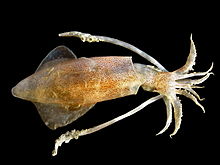
Back Loligo Catalan Loligo CEB Loligo Esperanto Loligo Spanish Varsinaiset kalmarit Finnish Loligo French Máthair shúigh (scuid) Irish Loligo Galician לוליגו HE Loligo Italian
| Loligo Temporal range:
| |
|---|---|

| |
| Live specimen of L. vulgaris from the Belgian continental shelf, photographed on board the RV Belgica. (ML: 138 mm, MW: 39 mm) | |
| Scientific classification | |
| Domain: | Eukaryota |
| Kingdom: | Animalia |
| Phylum: | Mollusca |
| Class: | Cephalopoda |
| Order: | Myopsida |
| Family: | Loliginidae |
| Genus: | Loligo Lamarck, 1798[2] |
| Type species | |
| Loligo vulgaris Lamarck, 1798
| |
| Synonyms | |
|
Pteroteuthis Ehrenberg, 1831 | |
Loligo is a genus of squid and one of the most representative and widely distributed groups of myopsid squid.
The genus was first described by Jean Baptiste Lamarck in 1798. However, the name had been used earlier than Lamarck (Schneider, 1784; Linnaeus, 1758) and might even have been used by Pliny. In the early 19th century, this generic name was often used as a grouping for all true squid.
All three species of Loligo are caught by commercial fisheries, most abundantly by traditional trawling methods (mobile gear). In the United States of America, Longfin squid are federally regulated under the Atlantic Mackerel, Squid, and Butterfish Management Plan. Loligo vulgaris and others are noted for being attracted to lights at night; they can therefore be fished using different light-attraction methods. Commercial fishing is heavily regulated in the United States, and fishing using mobile gear is only permitted during daylight hours. However, the recreational fisherman is often found sitting by a light at the pier, happily jigging for squid with a rod and reel.
Loligo is the oldest true squid genus known from fossil remains; statoliths assigned to the extinct species Loligo applegatei are known from the early Eocene. In addition, a pyritized imprint of a Loligo squid is known from the Oligocene of Krasnodar, Russia, marking the first true squid known from a complete body fossil. The squid appears to have suffocated in anoxic bottom water while attempting to eat an extinct cutlassfish (Anenchelum).[1]
- ^ a b Mironenko, Aleksandr A.; Boiko, Maxim S.; Bannikov, Alexandre F.; Arkhipkin, Alexander I.; Bizikov, Viacheslav A.; Košťák, Martin (10 August 2021). "First discovery of the soft-body imprint of an Oligocene fossil squid indicates its piscivorous diet". Lethaia. 54 (5): 793–805. doi:10.1111/let.12440. ISSN 0024-1164.
- ^ Julian Finn (2016). "Loligo Lamarck, 1798". World Register of Marine Species. Flanders Marine Institute. Retrieved 12 February 2018.
© MMXXIII Rich X Search. We shall prevail. All rights reserved. Rich X Search